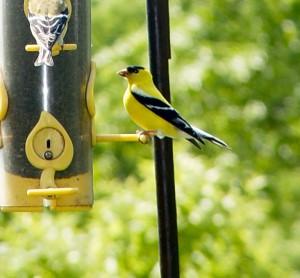Winter Wild Bird Care:

Well with the winter truely upon us, and the first falls of snow for some in the UK, we should maybe spare a thought for our little friends who have to spend all night huddled outside in the cold; and think of winter bird feeding recipes to help them survive the winter season.
Since there is not much to do in the garden, as preparation for winter-time has all been done …hasn’t it 🙂 Why not spare a thought for the robins and wrens, blue-tits and blackbirds, along with all the rest of the garden family that help keep these insects from the veggies in the growing season. A small bird like the blue tit has to eat a quarter of its body weight each day just to survive, and in the cold of winter this increases significantly.
Keeping a healthy population of birds around the garden over the winter, apart from the joy of just watching them, is a great tactic for the vegetable gardener as it can reduce the predations of bugs and insects on the veg if there is a healthy bird population around – yes ok..you do have to protect the soft fruits!
Wild Bird Food Ideas:
Birds of all different types require different foods, and so it is natural that wild bird feeding recipes vary a lot. Blackbirds for instance like fruit and so some chopped apples or pear can be a good addition to the mix on the bird table. A mixture of chopped up bacon fat or other pastry, mixed through with the usual wild bird seed products; will help in the cold weather when high fat, high energy foods are in demand.
The cost of peanuts have soared in recent years, mainly because of the demands of bio-fuel which is snatching up most of the peanuts leading to a huge rise in prices. This can make it extremely expensive if you have a busy garden! I spoke to a small coffe shop owner in Aviemore who uses 1 ton of peanuts yearly to feed his local bird life, and he is struggling with the costs – as you can imagine! However the cost of not feeding them is to drastic to consider, especially now that they have got used to his fine-dining experience – a major attraction for his cafe/garden centre clients.
which is snatching up most of the peanuts leading to a huge rise in prices. This can make it extremely expensive if you have a busy garden! I spoke to a small coffe shop owner in Aviemore who uses 1 ton of peanuts yearly to feed his local bird life, and he is struggling with the costs – as you can imagine! However the cost of not feeding them is to drastic to consider, especially now that they have got used to his fine-dining experience – a major attraction for his cafe/garden centre clients.
Fat blocks though seem to have dropped a little in price, so I have been dropping them down inside the peanut cage to try and reduce costs a bit. They’re not as popular as the peanuts – but beggars can’t be choosers as they say.
If you have any spare lard, try melting it in the frying pan and adding a mixture of birdseed and foodstufs like raisins, currents, dates, suet, oatmeal, porridge oats etc. Pour the mix into a little mould (anything suitable) and leave to cool and set. This is perhaps one of the most general winter bird feeding recipes as it appeals to a variety of different wild birds.
Don’t be afraid to experament when it comes to feeding the wild birds, and remember that any food is better than no food at all. As a basic rule of thumb however, stay away from salted foods such as salted peanuts; or overly sweet foods as they are not good for the birds at all. However if you have a line of birds on the fence and you only have salted peanuts in the cupboard, then try washing them out to remove the salt – then give them to the birds 🙂 Try and avoid bacon rind that is very salty also, but the addition of other fatty by-products of a fine meal would be ideal mixed in.
Preparing the bird boxes:
This is also a good time to clean out the bird nesting boxes, to make sure that they are not over-wintering vermin such as lice. Simply clear out the old nesting material, and if possible apply boiling water to kill off any critters. Adding some sawdust or wood shavings can be a good idea as the tiny wren for instance will some times rest overnight in the nest boxes – in fact several of these tiny birds will often huddle together in one box for warmth over the winter.
Birds like Robbins will often shelter over night in the wood shed or other garden shed to avoid the worst of the winter weather, and so if it is possible, leave a little access for them (bear in mind your own security needs though!).
The reward for all this effort is three-fold. Firstly you are doing these little creatures a great service and helping them survive. Secondly you have the pleasure of watching their activity (better than TV most times), and thirdly you are helping them to survive the winter so that they in turn will help your vegetable patch survive the growing season!
